Boardroom Comics: A Business-Scenario Visualization Tool For Executives
As a UX researcher, I’m always looking for novel ways to present information to the different audiences I work for. My collaborators and clients aren’t limited to UX designers, software developers and UI visual designers.
I regularly conduct studies for executives who are responsible for business strategy, product planning, operations, sales and marketing, and professional education. At the conclusion of each study, my challenge is to create a final deliverable tailored to a specialized audience.
In the past, my user-research deliverables have consisted of short videos, concept feedback, games, workshops, competitor audits, strategy documents, customer journey maps and very detailed personas. It was only recently that I thought a comic book would make a fine user-research deliverable. Sure, it might seem strange to create a comic book in a staid corporate environment, where they are thought of primarily as light entertainment. But it’s not strange at all.
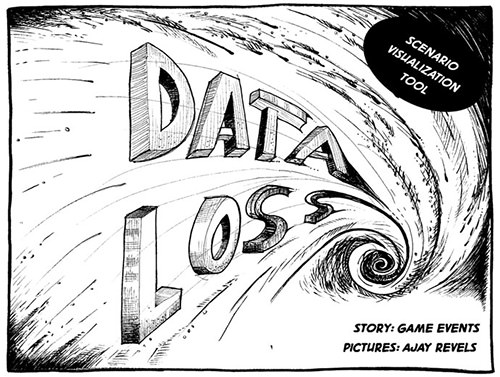
A comic book can be used to visualize scenarios. (Large preview)
Comic books are actually a very effective means of communicating difficult concepts to diverse audiences. Why? Because a comic book uses pictures, words and actions to make tricky topics easy to follow and understand. In contrast, a typical UX wireframe, strategy deck or functional specification document will often use “tech speak” and special shapes to communicate ideas.
In fact, sequential art, in the form of comic books, has been used in the US to effectively communicate a range of complex topics, such as military equipment maintenance in the 1950s. A prime example is PS Magazine, written by Will Eisner.

PS Magazine, an example of sequential art.
In 2006, Sid Jacobson and Ernie Colón wrote The 9⁄11 Report: A Graphic Adaptation to illustrate, “word for word the original report… even including the Commission’s final report card.” In October 2011, the U.S. Centers for Disease Control and Prevention (CDC) published “Preparedness 101: Zombie Apocalypse” to explain how to act in the face of a major “plague.” And in 2012, Kevin Cheng applied methods of sequential art to illustrate the process of planning for new technology products in See What I Mean.
In this article, I will discuss why I created a comic book to help a group of executives explore a business scenario that has multifaceted problems and is set in an imaginary future. I will also talk about how the comic book helped the executives experience the strategic and emotional impact of the problems and how it helped them noodle over possible solutions. Finally, I’ll provide some guidelines for UX designers who would like to use comics or sequential art to illustrate open-ended business scenarios.
Problem
Let’s start with a thorny concept most of us have heard of: cybercrime. It’s a mature industry with an extensive professionally run underground economy. As you might know, the cybercrime economy is based on the development and distribution of sophisticated tools to carry out large-scale fraud attacks, consumer-data breaches and politically motivated distributed denial-of-service (DDoS) attacks. These attacks on financial institutions, retailers and governmental agencies result in the loss of billions of dollars every year.
Now, imagine that you’re a managing director at a large corporation. You’re going about your normal business day when… BAM! The corporate website goes down; you learn that the call center is being flooded by panicked customers; and members of the media are calling you to comment on the surge of negative comments on your Twitter page. What should you do first? How are you going to respond to this crisis and return your business’ functions to their normal state?
These and other questions were running through my clients’ minds. They wanted to investigate how they might be affected by a hypothetical cybercrime, and they were asking questions. “What if we lost electricity?” “What if we lost control of the website or our mobile apps?” “What if sensitive customer data were stolen?” “What would we do?” Instead of waiting for a crisis to occur so that they could learn from the school of hard knocks, they decided to simulate a handful of devastating “What ifs” ahead of time in the form of a game.
Tools
Fortunately for my client, games that simulate business processes have been around for a while — since the 1950s, in fact. Business-simulation games enable facilities managers, operations directors, IT managers and even business students to explore a potential crisis, test their response, identify intelligence gaps and try out recovery plans before facing the crisis — whatever it might be — in real life.
While these games tackle serious problems, they are fun and thought-provoking and can generate a great deal of insight in just a few hours of play. Let’s look at a few games that enable organizations to enter and play inside possible futures.
- Table-talk role-playing games are a form of role-playing game. Each player takes on the role of a character whose choices shape the direction and outcome of the game. Players determine the actions of their characters, describe their characters’ actions through speech and have the freedom to improvise as the game progresses.
- Business war games simulate the moves and counter-moves in a commercial setting. Unlike military war games or fantasy war games, which can take place hundreds of years in the past, business war games are usually set in the present.
- Crisis-management drills have teams and participants practice aspects of an emergency response plan and prepare them for more extensive exercises — or the real event. Schools, hospitals and businesses generally conduct evacuation, shelter-in-place and lockdown drills with a large number of participants (including employees, students, staff, healthcare providers, firefighters and law enforcers) to demonstrate the steps they should take in an emergency.
- Scenario-based planning games allow organizations to test out and make flexible long-term plans. A game requires participants to act out possible yet very uncomfortable scenarios in today’s world. The plausible outcomes challenge assumptions, uncover blind spots and align people around common goals. A scenario-based planning game was used by my client to explore a hypothetical cybercrime event.
Game On
“We’ve been hacked!” Fourteen executives and administrators from across the business assembled in a conference room and were divided into three teams to tackle a scenario involving a data-loss crisis. One team represented the media, another represented the business, and the third became the hacker. The game took place over several hours one afternoon under the direction of a scenario master, who ran the game and recorded moves, decisions and dialog in the spreadsheet pictured below.

A spreadsheet is a way to record moves, decisions and dialog. (Large preview)
Comic Book
Once the data-loss game was played through, participants were scrambling for an easy way to:
- revisit team moves, decisions and dialog for future reference;
- look at each problem separately and brainstorm new solutions;
- share ideas for particularly thorny solutions with a wider audience.
I suggested that a comic book would be a natural solution to these needs. It would be easy to create, use, reproduce and share among the small group of players. I knew that storyboards and comics had been used successfully by UX professionals to illustrate user scenarios when designing interfaces. My book would be a slight departure in that it would illustrate an open-ended business scenario that involves multiple people with conflicting goals and no clear outcome. The book would be a thinking tool. It would not offer any clean workflows or happy endings.
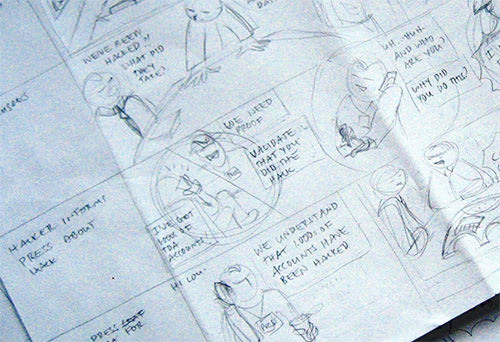
A storyboard of thumbnail sketches is a way to design the story. (Large preview)
Because I had been involved in planning the scenario game, I knew which artifacts to gather: the playing cards, the transcript of moves and dialog, and the list of team members, stakeholders and game goals. I translated the transcript of moves and dialog into 60 thumbnail-sized sketches. While this might sound like a lot of work, it took only four hours to complete, and the entire story fit onto four pieces of 11 × 17-inch (or A3) paper. This storyboard, or “wireframe,” made it easy for the scenario master and I to quickly arrange the scenes into a sequence that matched the overall flow of the game.
I designed each page to be a standalone worksheet that focuses on a particular problem encountered during the game, the people involved and the decisions they made. For example, the page below illustrates the probing questions of the media team and the reaction of the business team. For those of you wondering about the time required to ink the final pages, it was about one hour per page.
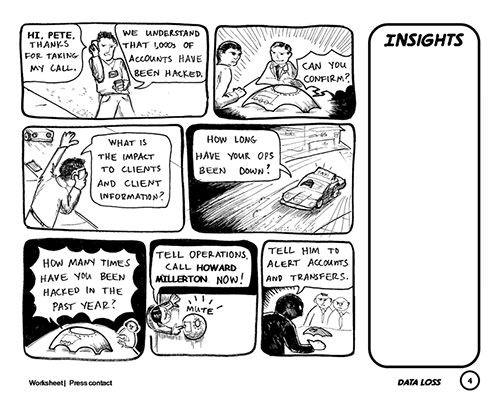
Each page also contains an “Insights” panel, sized to hold small sticky notes, which players can affix during future brainstorming sessions. (Large preview)
From start to finish, the book took two weeks to complete, following these basis phases:
- thumbnail the entire story: 4 hours
- sketch 12 pages in pencil: 3 days
- color 12 pages and print the dialog in black ink: 5 days
- copy and bind 15 books on 8.5 × 11-inch (or A4) paper at a local copy shop: 3 hours
The completed 13-page comic book consists of an introduction to the game, a list of participants, the game’s events and a few blank pages at the end for notes. Because the book was designed as a thinking tool rather than a set of recommendations, the players may remove worksheets from the book and pin them on a wall during future brainstorming sessions.
Lessons Learned
While the mechanics of creating the comic book were fairly easy, I learned a few things about designing a comic book to illustrate business scenarios, which you might find useful.
Characters And Settings
- Use role “archetypes,” instead of realistic depictions of participants.
- Give the characters believable names, but avoid using participants’ real names.
- Avoid making participants feel like a joke. No one wants to be the “ugly duck.”
- Portray all participants making rational decisions. Even “bad guys” are rational. No one is “stupid.”
- Depict real furnishings and equipment used by participants in their daily work.
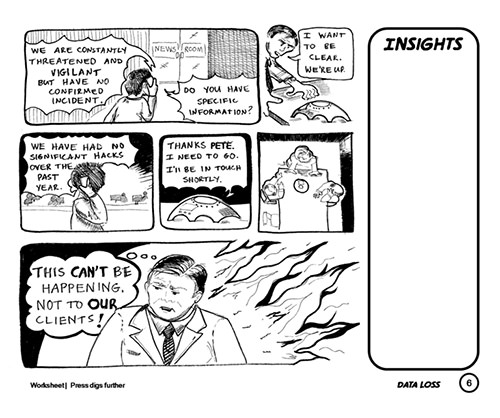
Each page focuses on a specific problem encountered by the players. (Large preview)
Action And Emotion
- Exaggerate emotion to help players remember their feelings months later.
- Include small visual jokes or inside jokes known to the participants. It’ll lighten the mood.
- Show characters taking action, no matter how small.
- Create interstitial people and events to bridge gaps in action.
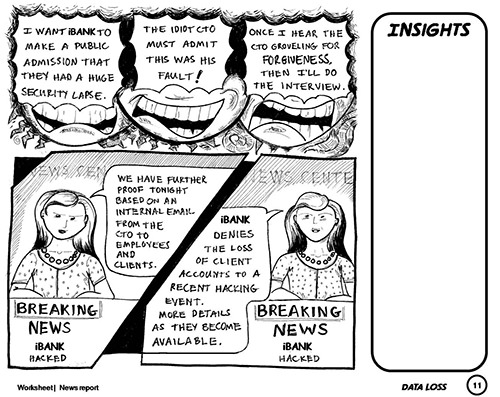
Each page depicts the emotional and factual environment encountered by the players. (Large preview)
Production
- Keep the comic short and sweet. Ten to fifteen pages are easier to create and to consume.
- Work closely with the scenario master to refine and focus the narrative.
- Test your penciled pages with a few participants to verify story flow and feelings.
Reality Check
Fortunately, my client was open to the idea of a comic book, and I was given the time to create one. But what if you are not in this situation? What if you’d like to illustrate a business problem in a comic-book format but your client or boss is skeptical or you feel that your drawing skill is limited or you simply lack the time? Consider this:
- Can you distill an aspect of the problem into one small storyboard of five to six thumbnails? If yes, then take five to ten minutes to create a mini-storyboard on one piece of paper, and use that to discuss the problem with your client. As most UX’ers already know, getting a client to respond to sketches is easier than getting them to visualize an idea using words. To sell the idea of a comic, use a comic. However, if the problem can’t really be “seen” or “felt” by people, then the problem is likely not a good candidate for a comic book.
- Are the people involved in the business problem moving through space, exchanging information or moving their bodies in some way? Stick figures or clothespin people will convey basic action and facial expressions just fine to trigger empathy in the reader. You can also use photographs with word bubbles to communicate activity, intent and dialog. But if you want to present more facial, emotional or physical detail in order to immerse the client in the problem, then you’ll need to make more detailed drawings.
- In the time it takes to create one wireframe of a website landing page, you can sketch five to six thumbnails of a story. The trick is to limit your initial sketching to just a few minutes. Show a quick sketch and get a response from your client before proceeding down the road of more detail. You may find that a quick sketch is fine and just needs a bit of cleaning up in order to be presentable. Indeed, a single page is pretty easy to create, but if you fancy developing an entire book, even of modest length, then you’ll need to budget at minimum a week or two.
The data-loss comic book turned out to be a very effective way to illustrate the events that unfolded during the scenario-based planning game. It captured the game play better than a written report, video or slide deck could have. And it provided the participants with a way to relive particular moments of the game and to revisit their decisions and ideas.
The next time you’re looking for an effective way to communicate a complex topic, consider making a comic book!
Further Reading
- The Smashing Cartoons
- Misunderstanding Markup: XHTML 2/HTML 5 Comic Strip
- The Celebration Of Cartoons and Comic Strip Art
- Drawing A Cartoon In Illustrator
- Cartoon – Mental Model Diagrams



 JavaScript Form Builder — Create JSON-driven forms without coding.
JavaScript Form Builder — Create JSON-driven forms without coding. Devs love Storyblok - Learn why!
Devs love Storyblok - Learn why!

 Get a Free Trial
Get a Free Trial Register For Free
Register For Free

